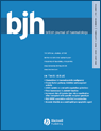Tissue factor pathway inhibitor anticoagulant activity: risk for venous thrombosis and effect of hormonal state
Summary
Full-length tissue factor pathway inhibitor (TFPI) is assumed to be biologically more important than truncated TFPI because of its stronger anticoagulant effect in the diluted prothrombin time (dPT) assay. We have developed a dPT-based assay for TFPI anticoagulant activity. Here, we report the effect of hormonal state on TFPI anticoagulant activity and whether TFPI anticoagulant activity assesses the risk for deep-vein thrombosis (DVT) better than conventional TFPI assays. We undertook a case-control study of 474 patients with DVT and 474 controls and compared the odds ratio (OR) for DVT for those with low TFPI anticoagulant activity with the ORs obtained for TFPI free and total antigen, and TFPI chromogenic substrate activity. Hormonal state affected clot time in dPT, but this effect was ameliorated by anti-TFPI antibodies. Low TFPI anticoagulant activity gave an OR of 1·5 (0·97–2·1) for DVT, similar to the ORs obtained with conventional TFPI assays, ranging from 1·2 to 1·4. Individuals low in both the activity assays obtained an OR of 5·9 (1·7–20). We concluded that the effect of hormonal state on dPT was mediated through TFPI, and a dPT-based assay of TFPI anticoagulant activity did not assess the risk for DVT better than conventional TFPI assays.




